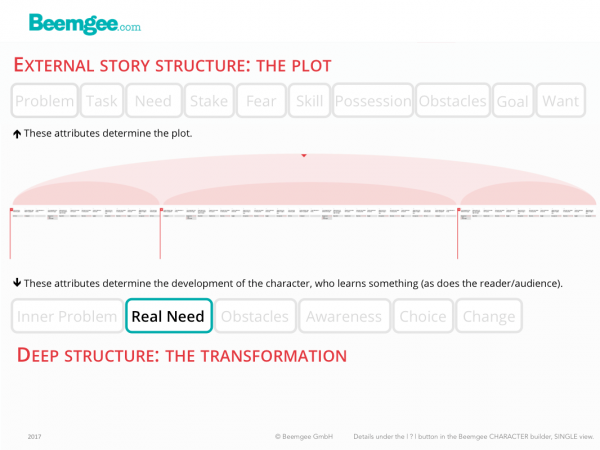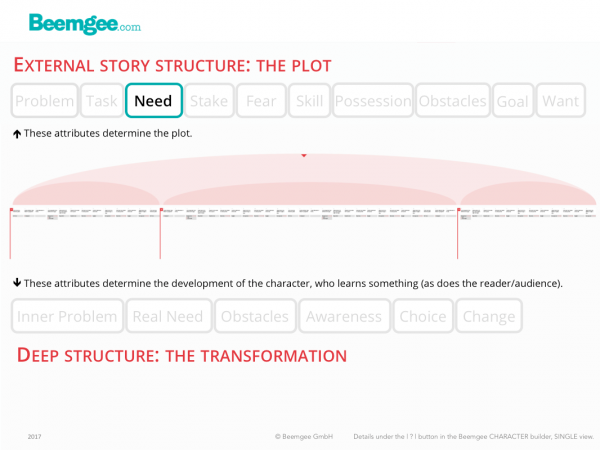
 Here at Beemgee, we’re into the thought behind the writing of stories more than the writing itself. So we’re all the more pleased that Writer.com approached us to talk about character development. While their speciality is AI-assisted text generation for companies, in their guest post, they have some good general advice on creating fictional characters. Thanks to Nicholas Rubright for this article. Nickolas is a digital marketing specialist and expert at Writer. In his free time, he enjoys playing guitar, writing music, and building cool things on the internet.
Here at Beemgee, we’re into the thought behind the writing of stories more than the writing itself. So we’re all the more pleased that Writer.com approached us to talk about character development. While their speciality is AI-assisted text generation for companies, in their guest post, they have some good general advice on creating fictional characters. Thanks to Nicholas Rubright for this article. Nickolas is a digital marketing specialist and expert at Writer. In his free time, he enjoys playing guitar, writing music, and building cool things on the internet.
Writing characters with whom readers can identify and empathize should be the goal of every writer, but it’s not a simple task.
To fully grasp a character’s motivations, desires, and anxieties, writers must dive deep into the character’s psyche. Character flaws and strengths work together to build a solid character.
But what is the most effective way to develop a character? And how can you establish a connection between your character’s dramatic decisions and the story itself?
Your characters are the heart and soul of your story. Thus, before you can write a single word, you must first understand your characters.
When it comes to character creation, you have several choices to make, and each choice affects the story in its own way. You must, however, choose what works best for your character.
While an unexpected detail can make the character more interesting, if it isn’t chosen carefully it can damage the character’s believability and ruin your reader’s immersion in your story.
Here are some guidelines and tricks to help you successfully create mouldable character templates for your story.
So, let’s dive in! (more…)

Nothing should be more important to an author than how their story makes the audience feel.
As an author, consider carefully the emotional journey of the reader or viewer as they progress through your narrative.
The audience experiences a sequence of emotions when engaged in a narrative. So narrative structure is a vital aspect of storytelling. The story should be touching the audience emotionally during every scene. Furthermore, each new scene should evoke a new feeling in order to remain fresh and surprising.
The author’s job is to make the audience feel empathy with the characters quickly, so that an emotional response to the characters’ situation is possible. Only this can lead to physical reactions like accelerated heartbeat when the story gets exciting. We have to care.
This “capturing” of the audience, making the reader or viewer rapt and enthralled, requires authors to create events that will show who the characters are and how they react to the problems they must face. The audience is more likely to feel with the characters as the plot unfolds when the characters’ reactions to events reveal something about who they really are – and how they might be similar to us.
One Journey to Spellbind Them All
Here we present a loose pattern that we think probably fits for any type of story, whatever genre or medium, however “literary” or “commercial”. It’s not prescriptive, just a rough checklist of the stages in the emotional journey the audience tacitly expects when they let themselves in on a story. The emotions are in more or less the order they might be evoked by any narrative.
Curiosity
(more…)

Where a character comes from may determine their values.
It is not always necessary to explain where a character comes from. Knowing their origin may not help the audience to understand a character.
But for some stories, origins can be vital.
As an example, take a contrast story like In The Heat Of The Night. Police Chief Bill Gillespie lives in the USA’s deep south and is a racist bigot. Such are his values, and for the purpose of this story also his internal problem. That he is a racist does not surprise the audience at all. It is completely credible given his origins. He comes from an area where, at the time at least, such bigotry was rife, and when the African American detective Virgil Tibbs turns up, their conflict is utterly plausible.
What we’re getting at here is that the values of a character have to be made plausible to the audience, which may be achieved by making the origins of that character explicit. In many stories, where a character comes from has to be fitting to what that character is like. Their origin produces the character’s values.
Setting, Origin, and Story World
Are we talking about setting? Well, only to an extent. (more…)

Author and creative writing teacher Jesse Falzoi was born in Hamburg and raised in Lübeck, Germany. Back in the nineties, after stays in the USA and France, she moved to Berlin, where she still lives with her three children.
She has translated Donald Barthelme stories into German. Her own stories have appeared in American, Russian, Indian, German, Swiss, Irish, British and Canadian magazines and anthologies. She holds an MFA in Creative Writing from Sierra Nevada College.
Her new book on Creative Writing is released end of May 2017.
At the age of twenty-one I quit university and bought a one-way ticket to San Francisco, USA. I wanted to get far away from my first attempts to grow up. I wanted to get away from a frustrating relationship and boring courses and everything that was pushing me to take life more seriously. I didn’t have any plans what I would be doing in San Francisco but I had the address of an acquaintance I had made a year before. I went on a journey that was physical in the beginning and became more and more spiritual during the process. I bought a return ticket in the end and went back to my hometown just to pack my suitcases for good; I’d be staying in Germany, but I wouldn’t be staying home.
(more…)
Action is character.
So the old storytelling adage. What does that mean, exactly?
In this post, we’ll consider:
- The central or pivotal action – the midpoint
- Actions – what the character does
- Reluctance
- Need
- Character and Archetype
The central or pivotal action – the midpoint
More or less explicitly, the main character of a story is likely to have some sort of task to complete. The task is generally the verb to the noun of the goal – rescue the princess, steal the diamond. The character thinks that by achieving the goal, he or she will get what they want, which is typically a state free of a problem the character is posed at the beginning of the story.
The action is what, specifically, the character does in order to achieve the goal (rescue the princess, steal the diamond). In many cases, this action takes place in a central scene. Central not only in importance, but central in the sense of being in the middle.
Let’s look at some examples. (more…)
In most stories, the protagonist has something to do.

The task is the more or less explicitly defined mission a character sets out on in order to reach the goal and thereby solve the external problem.
Many of the major characters in a story will have something to do, which may result in them getting in each other’s way.
Task as Function
In a story, more or less everyone has a task. What characters do in a story defines them and determines their roles and narrative functions in the story. In this sense, it is an antagonist’s task to get in the way of the protagonist; an ally’s task is to help the protagonist; a mentor’s task is to advise the protagonist and set them on their way.
But while all that is true, it isn’t really what we mean by task.
Task as Action
The characters’ actions make them who they are. To define a character’s task is to state clearly what that character has to achieve in the story. It is the action that leads to(more…)
In most stories, what a character really needs is growth.

Characters display flaws or shortcomings near the beginning of the story as well as wants. What they really need to do in order to achieve what they want is likely to be something they need to become aware of first.
The real need relates to the internal problem in the same way the perceived need relates to the external problem. The character has some sort of dysfunction that really needs to be repaired.
That means the audience or reader may become aware of a character’s real need long before the character does. Most stories are about learning, and learning entails the uncovering of something previously unknown. So the real need of a character is to uncover the internal problem, to become aware of their flaw.
A character may be unaware of their real need because they are suppressing a secret from their past. Something they did (better than something that happened to them) causes shame or guilt and they therefore hide it from themselves. To get over this, they must achieve some sort of healing. The trick is to dramatise such inner conflict through plot events.
To recap: The usual mode in storytelling has a character consciously responding to an external problem with a want, a goal, and a number of perceived needs. Unconsciously, that character may well have a character trait that amounts to an internal problem, out of which arises that character’s real need – i.e. to solve the internal problem.
So if a character is selfish, the real need is to learn selflessness. If the character is overly proud, then he or she needs to gain some humility. In the movie Chef, the father neglects his son emotionally – his real need is to learn to involve the child in his own life. The audience sees this way before the Chef does.
Even stories in which the external problem provides the entertainment – and with that the raison d’être of the story – may profit from(more…)
A character with a goal needs to do something in order to reach it.

The outward needs of a character – things she needs to acquire or achieve in order to reach the goal – divide the story journey into stages.
In storytelling, characters usually know they have a problem and there is usually something they want. They tend to set themselves a goal which they believe will solve their problem and get them what they want.
In order to get to the goal, the character will need something. Some examples: If the goal is a place, a means of transportation is necessary to get there. If we can’t rob the bank alone, we’ll have to persuade some allies to join our heist. If the goal is defeating a dragon, then some weapons would be helpful. If magic is needed, we’ll have to visit the magician to pick some up.
While the perceived need might be an object or a person, it usually requires an action. We’ll need a car, so do we buy one or steal one? We’ll need a sword, so do we pull one out of a stone or go to the blacksmith? If we need help, who do we ask and how do we talk them into joining us? We’ll need magic, but how do we find a magician? Ask an elf or go to the oracle for advice?
So, once the goal is set, a vision of the way to reach it opens up to the protagonist – and with that to the audience/reader. At the very least, the first step of the way presents itself. All this is what the character is conscious of.
In other words, the character forms a plan.
The plan is communicated more or less explicitly to the audience. The anticipation of how things will not go quite according to plan is part of the pleasure. There must always be surprises in store for the characters as well as for the audience.
Stages and Obstacles
The perceived needs are (more…)

 Here at Beemgee, we’re into the thought behind the writing of stories more than the writing itself. So we’re all the more pleased that Writer.com approached us to talk about character development. While their speciality is AI-assisted text generation for companies, in their guest post, they have some good general advice on creating fictional characters. Thanks to Nicholas Rubright for this article. Nickolas is a digital marketing specialist and expert at Writer. In his free time, he enjoys playing guitar, writing music, and building cool things on the internet.
Here at Beemgee, we’re into the thought behind the writing of stories more than the writing itself. So we’re all the more pleased that Writer.com approached us to talk about character development. While their speciality is AI-assisted text generation for companies, in their guest post, they have some good general advice on creating fictional characters. Thanks to Nicholas Rubright for this article. Nickolas is a digital marketing specialist and expert at Writer. In his free time, he enjoys playing guitar, writing music, and building cool things on the internet.






